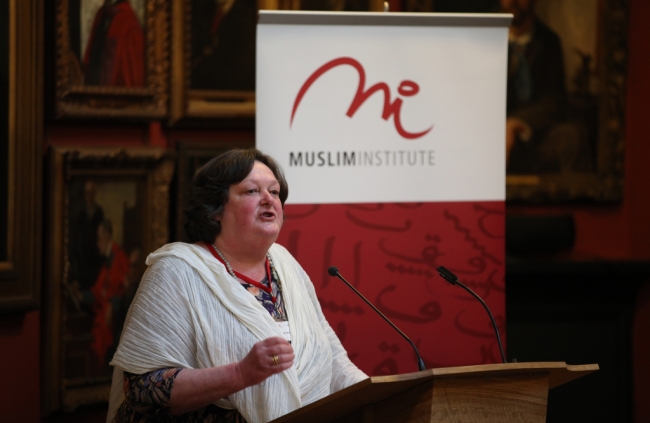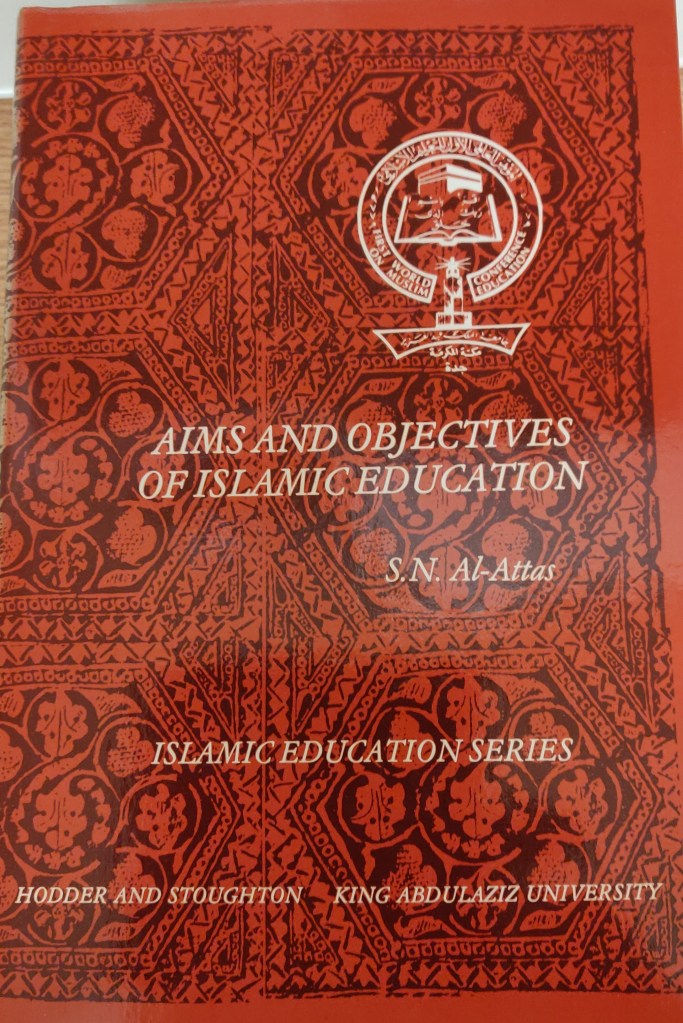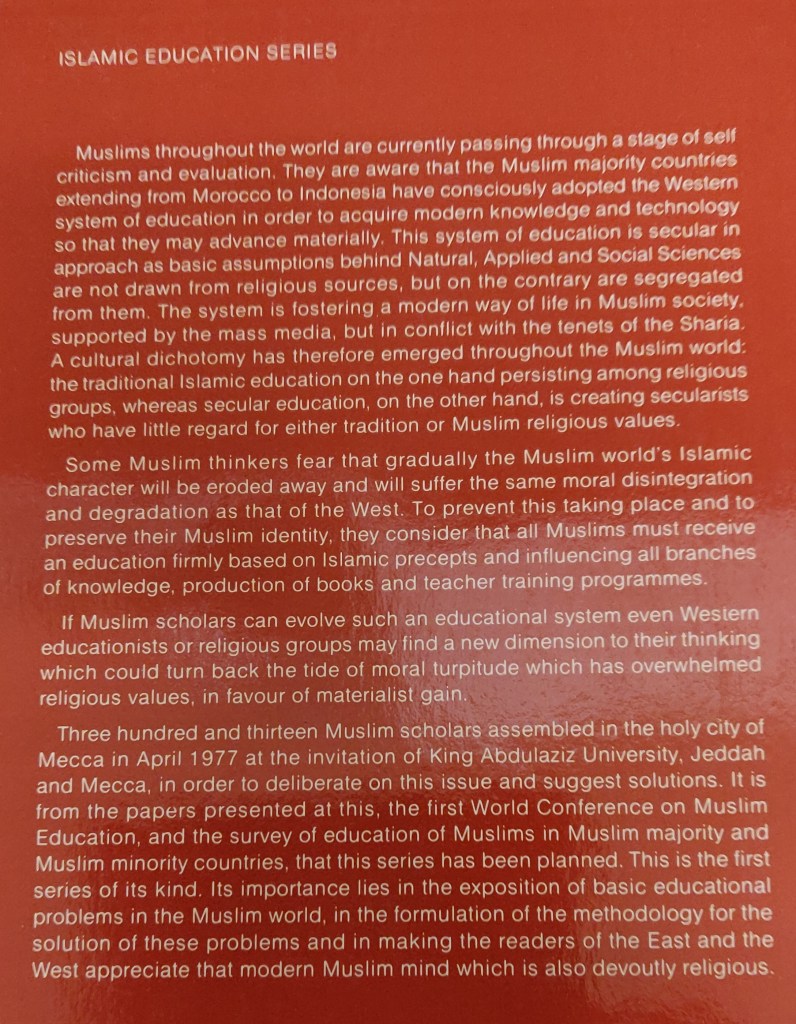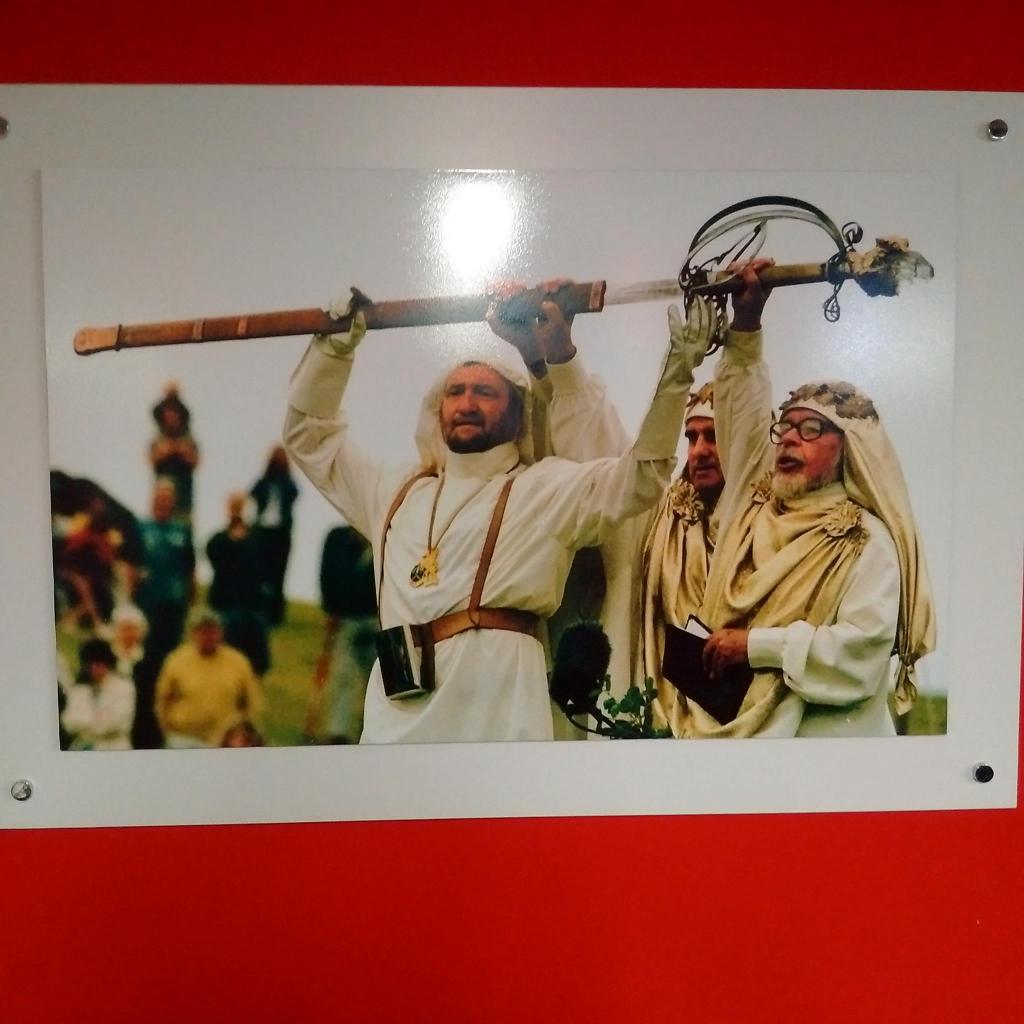
Introduction: British converts to Islam in the 1970s/80s: Stevens, Davis & Davies
Bismillah. Growing up in a devout, immigrant Pakistani Muslim family in London in the 1970s & 80s amidst a somewhat-racist society, my experience was that it was natural that white, European converts to Islam would attract a lot of attention within Muslim communities. The most famous convert/revert/new-Muslim was, of course, Yusuf Islam: formerly, the musician Cat Stevens.
But there were also a couple of female converts who became household names in Muslim activist circles: Maryam Davis & Merryl Wyn Davies. Naturally, these two women were often confused for each other, and I imagine that many people might have thought they were the same person, with Merryl adopting the name Maryam upon conversion. However, as MWD made clear in this interview with Wales Online on the 10th anniversary of 9/11, she never changed her name. (Her reasoning was spot-on: there is no Islamic requirement for anyone to adopt an Arabic name; the Prophet, peace be upon him, only changed names that had idolatrous, polytheistic or bad connotations. The use of an Arabic or “Islamic” name is entirely up to the individual, depending on their journey: there are pros and cons involved. Many people use both their original name plus a “Muslim” name as well, depending on the situation.)
Maryam Davis’ conversion story, 1980s
As a teenager, I remember attending a lecture to a Muslim audience by one of them about the story of her conversion: I’m fairly, although not entirely, sure that this was Maryam Davis. She began by clarifying the difference between her and the other “MD”: she was the one without the ‘e’ in her surname: she said that ‘Davies’ was a Welsh surname whilst ‘Davis’ was English [I think of Steve Davis, the snooker legend].
(Or was it MWD, saying that she did have the ‘e’ ?) The thing that struck me most about Maryam Davis’ lecture was when she spoke of different events as forming a connected, unified thread through her life: I’d never heard such a reflection before, but it prepared me for the Sufi commentary that I read decades later about the Qur’anic story of Musa (Moses) & Khidr (the “Green Man” who is connected to the English legends of St. George & the “Green Man” of nature), where the 3 actions for which Moses rebuked Khidr were all reflections of incidents from Moses’ own life. The only other thing that I remember from this lecture is that MD had witnessed the so-called “Islamic [read: islamist] Revolution” in Iran, and it had helped to inspire her to convert. “Imagine a crowd of hundreds of thousands of people, all shouting Allahu Akbar [God is Greater / God is Greatest] ?” she said.
(I haven’t heard any news about Maryam Davis since the 1980s, and would be grateful if anyone can provide some.)
Merryl Wyn Davies & the Muslim Institute, 2010s-2020s
The thing is, MWD had also been influenced by the “Islamic [read: islamist] Revolution” (in Muslim circles, who wasn’t?), as she mentioned in her 2011 Wales Online interview. But she was later instrumental, along with Prof Zia Sardar & Dr Ghayasuddin Siddiqui, in transforming the Muslim Institute, which had been strongly pro-Khomeinist (Shia islamist) under the leadership of Dr Kalim Siddiqui during the 80s & 90s, into a Fellowship-based organisation since the 2010s that is overwhelmingly critical of islamism. For example, its Winter Gathering 2019 was themed, Iran – The Revolution Goes Wrong.
See also this short but insightful speech by MWD at the MI’s inaugural Ibn Rushd lecture.
The Islamic Education Conference, Mecca, 1977

I first met MWD around 2010/11 at a MECO iftar in Oxford. She told me about the new Fellowship-based revamping of the Muslim Institute and encouraged me to join, which I did. After that, I met her almost every time I attended an MI event, which was probably every other year on average. So in total, I only met her half a dozen times or so, but it was always very inspiring to meet her and she left a deep impression on me because of her welcoming nature and love of life, people and knowledge.
She once told me that she had covered the above conference in Mecca, hosted by the Muslim World League and the King Abdul Aziz University, for the BBC or other international, English media. Given the difficulties for a woman to direct and produce media interviews in Saudi at the time, she had turned her hotel room into a makeshift studio. My recollection of her account is that this was at the Intercontinental Hotel that was just outside Mecca, outside the limits of the haram sanctuary, so non-Muslims are allowed to stay there (MWD converted to Islam a few years after the 1977 conference, in 1981).
The Islamic Education Conference of 1977 was clearly very influential: 313 scholars from around the world assembled in Mecca. (Almost certainly, the number 313 was deliberately chosen to match the number of Muslim warriors at the first, historic and decisive battle between Islam and its 1,000-strong enemy at Badr, between Mecca and Medina.) It also came about a year after the 1976 World of Islam festival in London that notably attracted an editorial in The Times newspaper. (I have listened to audio recordings of all the main lectures from the WOI festival, along with Q+A.) Many scholars would have attended both conferences.

The influence of this conference around the Muslim world is obvious from a list of the editors and contributors to each volume:
- Aims & Objectives of Islamic Education, ed. Syed Naqib Al-Attas
- Crisis in Muslim Education, ed. Syed Sajad Husain & Syed Ali Ashraf
- Education & Society in the Muslim World, ed. Mohammad Wasiullah Khan
- Curriculum & Teacher Education, ed. Muhammad Hamid Al-Afendi & Nabi Ahmed Baloch
- Social & Natural Sciences, ed. Ismail Rajhi Al-Faruqi & Abdullah Omar Naseef
- Philosophy, Literature & Fine Arts, ed. Seyyed Hossein Nasr
Further Contributors:
Saeed Ateyya Abu Aali, Abdul Haq Ansari, Muhammad Anwar, Muhammad al-Aroosi, Zaki Badawi, Ilyas Ba-Yunus, Ahmad al-Beely, AK Brohi, Ibrahim Titus Burckhardt, Abdul G Chaudhri, Prince Muhammad al-Faisal, Syed Altaf Gauhar, MM Ghaly, Abdul Hamid al-Hashimi, Peter Hobson (Ismail Abdul Baqi), SM Hossain, Sayyid Waqar Ahmad Husaini, Ahmad Salah Jamjoom, Kazi A Kadir, Syed Ali Muhammad Khusro, Abdul Halim Khaldoon Kinany, Ahmed Rifat Abdul Latif, Saibo Mohamed Mauroof, Jean-Louis Michon (Ali Abdul Khaliq), Abul Hasan Ali Nadwi, HM Abdul Quddoos Qasmi, Muhammad Qutb, Afzalur Rahman, Ata-ur-Rahman, Muhammad Al-Ahmed Al-Rasheed, Ghulam Nabi Saqib, AFA Sayeed, Ahmed Shalabi, Muhammad Ansar Ahmed Shami, Hadi Sharifi, Abdul Hamid Siddiqui, Kalim Siddiqui, Mohammad Nejatullah Siddiqui, Abdul Hamid Abu Suleiman, Basheer Tom, SM Yusuf.
(The reader will notice that the above list of scholars is entirely male. This underlines MWD’s perseverance to conduct dozens of interviews as a young, Welsh woman in a very male world on the outskirts of Mecca.)

I have actually never read these volumes, although they’ve been in my possession for over 20 years, but I plan to do so now God-willing, and partly to honour Merryl.
Back to the Muslim Institute, 2010s
At the 2016 Winter Gathering, during the “ISIS years,” I was asked to speak about Wahhabism. I think I was expected to focus on its negatives, given a talk I had given there 3 years earlier in 2013 that had been written up as an anti-Wahhabi polemic by Andrew Brown of The Guardian. (I had begun that or an earlier talk by saying what an honour it was to address the annual Muslim Institute gathering for the first time, in the presence of so many honourable friends and especially childhood inspirations: in the latter category, I specifically named Ziauddin Sardar and Merryl Wyn Davies, who inspired me separately but obviously did great work together for decades.)
However, as a Wahhabi-Sufi or Salafi-Sufi (“Salufi”), the gist of my talk was that the negatives were well-known, and I focussed on the positives of Wahhabism/Salafism: a strict egalitarianism and rejection of ultimate authorities besides God and His Prophet; a rejection of superstition and other harmful innovations, as opposed to good innovations; an emphasis on a return to the authentic sources, reason and spirit of Islam; promotion of some women’s rights, including female imams & women’s rights to divorce; a rejection of madhhabism, including the absurd practices of multiple prayer-services according to the different timings and methods of schools such as the Hanafi & Shafi’i. (Multiple prayer-services and sectarian minbars/pulpits had been correctly abolished under Wahhabi/Salafi influence in Mecca, Damascus & elsewhere.)
I argued that the MI crowd in practice were influenced positively by aspects of Wahhabism, since they weren’t into madhhabism, rigid legalism or superstition and fake sufism. I also argued that the narrow-mindedness and intolerance of many Wahhabi groups was not unique to them, but actually shared by many traditionalist Muslims, whether Sunni or Shia. In fact, Wahhabism could be regarded as the most conservative and puritanical interpretation of Sunni Islam: it was a failure of Sunnis, and Muslims generally, to blame problems like Al-Qaeda & ISIS purely on Wahhabism, when in fact these groups quoted medieval Sunni texts all the time. (As one scholar at the Sufi-friendly 2015 Marrakesh Declaration conference put it: we cannot condemn ISIS for reintroducing slavery etc. and simultaneously teach jurisprudential texts about such matters all the time in our seminaries! We must reform our curricula to help stop any resurgence of ISIS.) I suppose that some of my arguments are similar to those of Natana Delong-Bas’ Wahhabi Islam.
I was dreading a hostile reception, since the MI crowd are not exactly fans of Wahhabis/Salafis. However, I was pleasantly surprised at the generally positive, or at least neutral, reception I received. And it was Merryl who took the time to engage with me most profoundly, recommending that I read Geoffrey Robertson’s book about The Levellers, a movement that had evolved from the Puritans and were early Western radical democrats. (The Puritans under Oliver Cromwell had banned the celebration of Christmas in the UK – I had mentioned in my talk that this was a parallel with Wahhabi and other puritan movements within Islam.) I haven’t read this book yet, but plan to do so now God-willing, and partly to honour Merryl.
She was approximately Mum’s age, and always had that kind, motherly approach to complement her uncompromising devotion to principle and her sharp wit. At that last meeting, she also asked me directly, rather than listening to hearsay, about something Ayaan Hirsi Ali had attributed to me on BBC TV. I confirmed that Ali had misquoted me. “I thought so,” Merryl replied in her lovely Welsh accent, “I nearly fell off my sofa when she claimed you’d said that!”
As the Muslim Institute’s touching tribute to Merryl shows, she was very proud of her Welsh heritage and referred to the Wales men’s rugby team as “my boys.” My last interaction with her, as far as I can remember, was when I posted some photos on Facebook of my 2018 tour of the Principality (formerly Millenium) Stadium in Cardiff, home of her national team. Merryl commented on the following photo from the stadium display, showing men dressed in traditional Welsh warrior costumes, holding a large, partially-sheathed sword. (I was struck by this photo because of the similarity to traditional Arab/Eastern/African costumes.) Merryl explained the traditional Welsh cries associated with a particular festival, where they unsheath and then sheath the sword and make several exclamations about upholding peace.

I learnt of Merryl’s departure, and her final resting place in the blessed city of Kuala Lumpur, yesterday afternoon. After sunset prayers, we prayed the funeral prayer in absentia (salat al-janazah ‘ala l-gha’ibah / janaza ghaebana) for her as a family.
Merryl was a Muslim in the technical sense for 40 years, from her conversion to Islam in 1981 to her death this year, 2021.
She was working for the Muslim Council of Britain (MCB) when 9/11 happened, helping with their communications. She returned to God the day after the MCB announced its first female Secretary-General, who had won the election for that post. I don’t know much about the new Sec-Gen, or whether or not this news reached Merryl, but there is no doubt that she was one of the pioneering female activists within British Muslim communities for a whole generation, or even lifetime (40 years), before this historic moment. I’m sure Merryl would have welcomed the fact that a Muslim woman had finally broken this glass ceiling.
Our heartfelt condolences to all her family and friends on our collective loss.
Her name meant ‘a small thing from the sea’ in Welsh. Her hometown name, Merthyr Tydfil, means “(Mausoleum of the Relics of) Tydfil the Martyr” after a female, Christian, pre-Islamic Welsh martyr (5th century CE).
May Allah receive our “Merryl of Merthyr” with Mercy, accept her as a martyr (witness and shaheed to God) and shower upon her infinite Oceans of Love, Truth and Peace: values that she upheld valiantly throughout her blessed life. Amin.
U.H., London, UK, 4th February 2021 / 21st Jumada al-Thani 1442 (daytime)
Edited: 6th February 2021 / 24th Jumada al-Thani 1442 (after sunset)
Postscript: On 6th February 2021 / 23rd Jumada al-Thani 1442 (before sunset), about a dozen of us met online to discuss issues and possible solutions related to the needs of British converts/reverts to Islam. We ended the meeting by fittingly saying a collective prayer for Merryl and praising God for her inspiring life.
Tags: BBC, biography, British, Islam, Mecca, Merryl Wyn Davies, Muslim Institute, Muslims, Wales
February 4, 2021 at 2:29 pm |
inna lillahi wa inallah-e-raji’oon.
February 6, 2021 at 6:44 pm |
(Translation:) Truly, to God we belong. Truly, to God we return. [Qur’an]